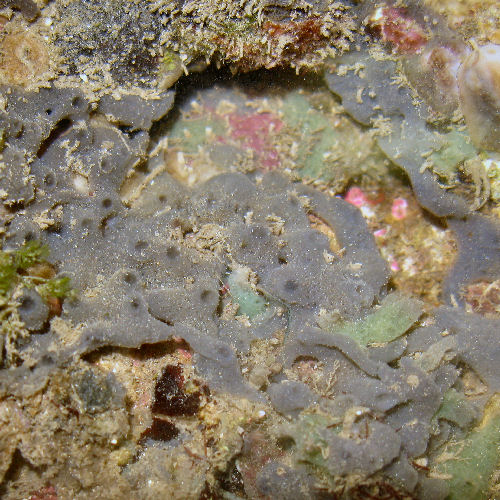| Common names: |
None. |
| Growth Form: |
Creeping branches less than 1 cm thick, with tube-like oscular elevations ~1 cm high and 0.5 cm in diameter; lateral expansion up to 25 cm or more. |
| Surface: |
Smooth to the eye, but faintly hispid, distinctly porous. |
| Color: |
Purple-grey, dark pink, occasionally light brownish. |
| Consistency: |
Soft, compressible, limp, easily damaged. |
| Exudate: |
None when squeezed. |
| Oscules: |
At the ends of tubes or elevations, diameter less than 0.5 cm. |
| Skeletal components (Spicules, fibers): |
Smooth often curved rods with both ends pointed (oxea), (115-147-170 x 4-7 μm). Spicules cemented by spongin at the tips, occasionally entirely enclosed. |
| Skeletal Architecture: |
No continuous special exterior skeleton; surface pierced by spicule tracts from the interior (hispid). The superficial (ectosomal) meshwork is discontinuous, with more or less triangular meshes. Interior: polygonal to rectangular skeletal meshwork, basically built by 1-2 spicules forming ascending continuous lines interconnected by individual spicules. Occasional scattered thicker bundles of up to 3-8 spicules entirely enclosed in spongin. |
| Ecology: |
Very common on lagoon bottoms and on mangrove roots, but also found on reef flats, and on rocks in shallow water. |
| Distribution: |
North Carolina, Florida and throughout the Caribbean to at least 5 m. |
| Notes: |
Purple-grey very soft creeping branches are probably diagnostic, but Chalinula molitba may be similar in looks and texture. This species is more spongy-compressible, slightly less fragile, and the surface is more coarsely hispid. Its spicules usually much shorter (up to 100 μm) and usually are entirely enclosed in spongin. |
| Reference(s): |
George & Wilson, 1919 (as Reniera); de Laubenfels, 1936 (as Haliclona permollis); Wiedenmayer, 1977 (as Haliclona aquaeductus; van Soest, 1980 (as Reniera); de Weerdt, 2000 (in part). |
| Similar species: |

Chalinula molitba |
|

